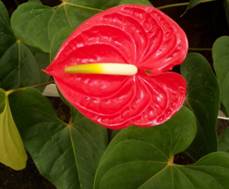
Crop: Anthurim
Scientific name :
Common / Local Name :

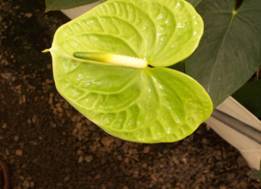
Anthurims are a beautiful group of tropical aroids. Plants normally grown epiphytically (like on trees). They are horticulturally divided into two sections viz., foliage type and flowering types. Though all Anthurims bear flowers, in the flowering types the spathe is large and very ornamental, but the foliage is not so attractive as those in the foliage section. The spathes have a great export potential and they stand well in transport.
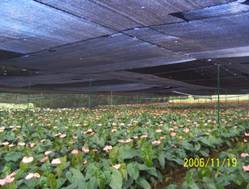
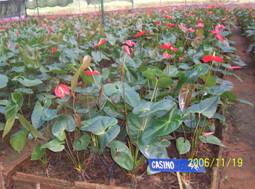
Anthuriums grow naturally in a shaded environment, well protected from extreme weather conditions.  When growing Anthuriums, provisions should be made for the natural characteristics of the plant and it must be protected from several weather conditions like wind, rain, heat, sunlight, temperature and relative humidity.
During the monsoons plants may be covered with a shadenet so as to avoid the direct showers as it increases the risk of diseases and the media used decomposes faster.
ÂTemperature: Being a tropical crop minimum temperature is 15o C to 17o C and maximum temperature is 32o C to 35o C. For good quality flowers and production fluctuation in low and high temperature is detrimental. However if relative humidity is maintained then most of the problems are avoided.
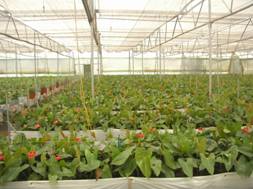
Humidity: This is an important factor for growing Anthuriums 65 to 85% humidity is ideal for quality and production of flowers. In greenhouses / shade houses fogging system or misters would be ideal. For open cultivation the surrounding area can be sprayed to maintain required humidity in addition to use of gravel/coconut husk etc.
Sunlight:Â Anthurium is a shade loving plant it requires 75% shade. Too much light/sun causes the flower to fade and the leaves show signs of scorching or burning effect.
Anthurium plantation last between 6 �7 years, therefore when choosing media it is important to select material, which does not decompose easily. Media like charcoal, coco pit, coco husk, sand, gravel, brick pieces etc are ideal as they have high water retention capacity and facilitate easy drainage besides providing support to the plants.
Planting can be done all year round but care should be taken to avoid planting in extremely hot or cold periods, as young plants are very sensitive and cannot grow under such circumstances. They may be planted in pots or in beds. The media before planting may be sterilized with choropyriphos @ 1.5 ml / litre of water. The media may be washed two or three times and then dipped in the insecticides solution for 1 minute. Then immediately put in pots or bed and start planting. The row-to-row distance may be maintained at 30 cm distance and plant-to-plant 45 cm. Additional; coconut shells may be added while planting for support.
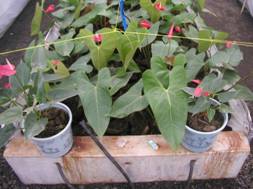
Once the planting is finished watering may be carried out for 2 � 3 weeks without any fertilizer application. The growing media should be sufficiently wet all the time after 15 days of planting fertilizers may be added to the water. Normally two irrigations are ideal. The first in the morning and 2nd by afternoon. During very hot weather the 3rd watering may be added.
Weed infestation is a chronic problem in rice cultivation. The loss caused by weeds ranges from 30�0% including quality deterioration of the grain. The first 35�40 days of the crop is the critical period for weed competition.
In addition to the Organic manure used along with the media at the time of planting, a dose of fertilizer may be added to the irrigation water i.e. either through drip system or can watering. Irrigation water should be given @ 5 lit of water per sq.mt. Check pH and EC value before every irrigation.
Ideal pH : 5.7-6.2 and EC: 1.2-1.3
A-tank solution:
S.NO |
Nutrient |
Quantity/1000litres of water |
1 |
Calcium nitrate |
32.4kg |
2 |
Ammonium nitrate |
8.0kg |
3 |
Potassium nitrate (13:0:45) |
14.2kg |
4 |
Iron chelates 3% |
2.8kg |
5 |
Nitric acid 38% |
0.01litre |
 B-tank solution:
S.NO |
Nutrient |
Quantity/1000litres of water |
1 |
Potassium nitrate (13:0:45) |
11.0kg |
2 |
Mono potassium phosphate (0:52:34) |
13.6kg |
3 |
Potassium sulphate (0:0:50) |
8.7kg |
4 |
Magnesium sulphate |
24.6kg |
5 |
Borax |
192.0g |
6 |
Zinc sulphate |
87.0g |
7 |
Copper sulphate |
12.0g |
8 |
Sodium molybdate |
12.0g |
9 |
Phosphoric acid 59% |
0.01litre |
Equal quantities of solution from Tank-A and B respectively mixed and diluted to 100 times in Tank-C. The pH and EC is corrected to required level before application to plants. Â
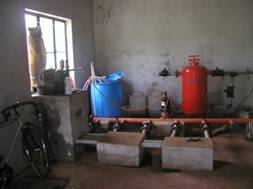
Red Spider mites, Cyclamen mites, Caterpillars, Thrips, snails etc.
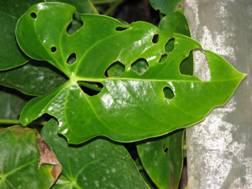
1]Â Â Â Â Â Â Â Â Â Â Â Red spider mites:
Spider mites are very small, oval shaped insects. They cause young leaves and buds to wither. They bore through the plant cells and suck up the contents, causing the cells to take on a silver white discoloration. They actually feed on the old leaves.
Management
- Spray Kelthane @ 1 ml / litre or Vertimec @ 4 ml / litre at least one to two sprays early in the morning or late in the evening.
2]Â Â Â Â Â Â Â Â Â Â Â Cyclamen:
The damage is mainly discoloration, blocking or disfiguration of the leaves or flowers. These mites cannot be seen with the naked eyes.
Management
- Spray with Vertimec @ 0.4 ml/litre at least two sprays at 4 �5 days interval on the plants or wettable Sulphur 1.5 mgs/ litre of water.
3]Â Â Â Â Â Â Â Â Â Â Â Caterpillars:
The larva of the tomato looper, the Beet Army worm and other caterpillars chew large holes in the leaves and flowers or scrap off plant tissue from the rear of the leaf.
Management
- Spray with Lannate @ 1 ml /litre or Decis @ 0.5 ml/ litre. Make sure to cover the complete leaf area with the chemical while spraying.
4]Â Â Â Â Â Â Â Â Â Â Â Thrips:
The insects have two pair of wings and are light yellow brown in colour. Thrips damage shows up as a brown strip on the leaves and flower. The insect bores through the cells and sucks up the contents.
Management
- Spray Nuvacron 2 ml / litre of water.
5]Â Â Â Â Â Â Â Â Â Â Â Snails:
They chew the root tips, damaging the leaves and buds. If the leaves show large number of small bubbles, this is usually caused by snails scaling off the tissue on the underside of the leaf leaving a brown layer of the cork.
Management
- Use a snail guard. Spray Metaldehyde with mixture of chick feed by which snails are attracted which can be collected in the morning and thrown off.
Bacterial Blight, Erwinia, Pseudomonas solanacearum, Fungal Diseases like Anthracnose, Root Rot, Fusarium spp.
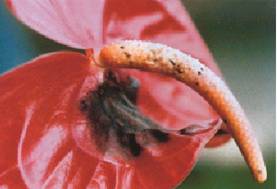 Flower blight in Anthurium
Flower blight in Anthurium
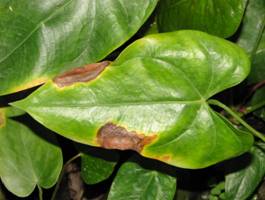
- Bacterial Blights
This disease is found mostly on leaves and flowers. This shows brown spots in the middle and yellow at the edges. Blight damage spreads quickly and will cover large sections of the leaves. Sometimes bacterial blight becomes systemic killing the entire plant.
Management
- Spray the plants regularly with Streptomycin Sulphate @ 1 gm / litre every 8 �10 days interval at least 6 �8 times.
- Erwinia:
Yellowing of the leaf, strong at the base of the stem, rising along the main vein particularly in young plant material.
Management
- Spray plants with Streptomycin Sulphate @ 1.5 gm / litre of water.
- Pseudomonas
Necrotic spots that follow the veins, sometimes bordered by the veins. The black spots often have a yellow fairy thin circle.
Management
- Spray plants with Streptomycin Sulphate @ 1 gm / litre of water regularly at every 8 days interval at least 8 sprays.
- Root Rot
Root rot is a secondary fungus that occurs when the plants growing conditions are not ideal such as fluctuations in wet and dry root media and cold. The leaves turn yellow at the edges and hang limply. The roots look brown. Root rot can also be caused by Phytophthora spp. The roots and tem shows brown discoloration.
Management
- Or drenching with Furalaxly 25% @ 1 gm/ litre of water.
- Nematodes:
The roots display brown spots instead of swellings. In the lesions are young eelworms, which will choke off the root in a short time.
Management
- Spread Neem cake @ 5 �7 gm / sq mt.
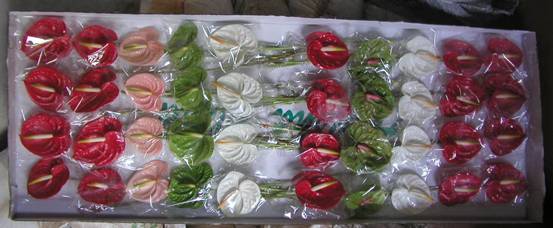
Harvesting:  Flowers can be harvested 6 �8 months after planting. In the 1st year we can expect 5 �7 flowers per plant and 10 �12 flowers by the end of 2 years. Authurim flowers are generally harvested early in the morning. The flowers are put in a container of water. Leaves of anthurium also fetch a good price.
Input availability |
Address/Contact details |
| Tissue culture plants | KF bioplants, Pune, Florance Flora, Bangalore, SPIC, Coimbatore |
Fertilizers |
For detailed list kindly click here |
Pesticides |
For detailed list kindly click here |
| Machineries | Department of Agriculture, Panaji, Goa tractors and Tillers, Mapusa |
|